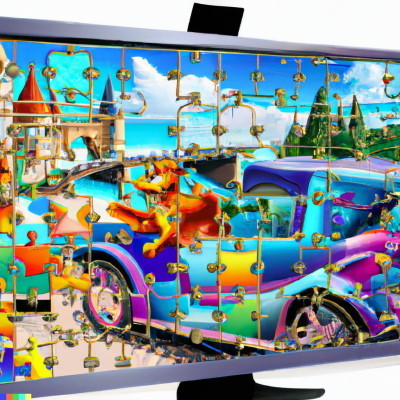
Getting started with video jigsaw puzzles
Solving a video jigsaw puzzle can be a fun and rewarding activity. There are a lot of similarities with solving a traditional jigsaw puzzle but there are also some significant differences. Here are some tips to help you get started:
Choosing a puzzle
When starting out, you may want to choose a puzzle video clip where the action is not too fast. Action movie segments often have fast moving sequences such as car-chases or dramatic fight scenes. They typically also include abrupt transitions such as jump-cuts. These are great for advanced puzzling but can be overwhelming when starting out. Pick a clip that is a bit slower moving. Drone shots of scenery or buildings are often a good choice.
It is also best to pick a puzzle that has identifiable elements. So, for instance a clip of buildings or trees can give you a clue of the correct orientation of a piece, while an abstract rotating spiral will not. Video clips of scenery will often have the sky in frame at the top of the puzzle and grass or foliage at the bottom.
Jigsaw piece rotation
Allowing the jigsaw pieces to be randomly rotated adds complexity to the puzzle. When starting out you can limit this so that all the pieces will be correctly oriented. This makes a big difference if you have chosen a video with an abstract subject or where there is no obvious clue as to which way is up or down. For example a clip of a rotating galaxy of stars.
Jigsaw size considerations
Many people starting their first video jigsaw will have lots of experience with traditional jigsaws. This experience can lead the player to choosing a puzzle with too high a piece count. Depending on the subject, a video jigsaw puzzle can be ten times more challenging than a traditional puzzle of the same piece count. Expect a 400-piece video puzzle to take at least 4 hours to complete. A good size to start for an adults first puzzle would be 25 to 45 pieces. You can always choose again if it seems too easy.
Sorting pieces
Experienced puzzlers will often sort the pieces into edge/interior pieces and group them by color. In the case of a video jigsaw, it is still useful to sort edge and corner pieces, but since the content of each piece is always changing it can be challenging to sort by color. Of course this will depend on the subject of the video clip. A static tripod video clip of a building will be very different from a fast action scene from a kung-fu movie.
Because video jigsaw puzzles are electronic, a player can choose to hide the interior pieces and work only on the edge pieces. Like a traditional puzzle, it is often easier to complete the puzzle when the edge pieces are assembled. There are exceptions however: Consider a video of a view of the earth rotating in space. In this case the edges are mostly black with the occasional star but the interior pieces have the familiar shape of countries rotating with the earth, so starting in the middle may be the best approach.
When the action is fast, groups of video jigsaw pieces can be identified as the player's eye is drawn to a screen element move or pass over several pieces scattered around the screen. For example in a car-chase scene a car (or part of it) may briefly appear to pass through a number of pieces in quick succession. This is a clue that these pieces are related, and they may be fitted together or moved close to each other for further arranging as the video progresses.
The most important thing
Remember, the most important thing is to have fun and enjoy the process of solving the puzzle. Don't feel like you always have to solve the biggest or fastest puzzle, or feel compelled to solve them all at once. It's okay to take breaks and come back to it later. Sometimes, stepping away from the puzzle for a little while can help you see things in a new light and find pieces that you might have missed before. With patience and persistence, you will eventually complete the puzzle and see the full video unfold.
